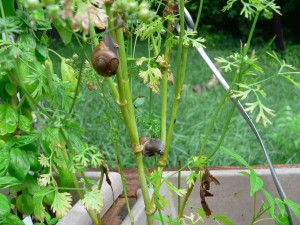Salmonella continues to rank as one of the most costly foodborne pathogens, and more illnesses are now associated with the consumption of fresh produce.
 U.S. Department of Agriculture Microbiological Data Program (MDP) sampled select commodities of fresh fruit and vegetables and tested them for Salmonella, pathogenic Escherichia coli, and Listeria. The Salmonella strains isolated were further characterized by serotype, antimicrobial resistance, and pulsed-field gel electrophoresis profile. This article summarizes the Salmonella data collected by the MDP between 2002 and 2012.
U.S. Department of Agriculture Microbiological Data Program (MDP) sampled select commodities of fresh fruit and vegetables and tested them for Salmonella, pathogenic Escherichia coli, and Listeria. The Salmonella strains isolated were further characterized by serotype, antimicrobial resistance, and pulsed-field gel electrophoresis profile. This article summarizes the Salmonella data collected by the MDP between 2002 and 2012.
The results show that the rates of Salmonella prevalence ranged from absent to 0.34% in cilantro. A total of 152 isolates consisting of over 50 different serotypes were isolated from the various produce types, and the top five were Salmonella enterica serotype Cubana, S. enterica subspecies arizonae (subsp. IIIa) and diarizonae (subsp. IIIb), and S. enterica serotypes Newport, Javiana, and Infantis. Among these, Salmonella serotypes Newport and Javiana are also listed among the top five Salmonella serotypes that caused most foodborne outbreaks. Other serotypes that are frequent causes of infection, such as S. enterica serotypes Typhimurium and Enteritidis, were also found in fresh produce but were not prevalent. About 25% of the MDP samples were imported produce, including 65% of green onions, 44% of tomatoes, 42% of hot peppers, and 41% of cantaloupes. However, imported produce did not show higher numbers of Salmonella-positive samples, and in some products, like cilantro, all of the Salmonella isolates were from domestic samples. About 6.5% of the Salmonella isolates were resistant to the antimicrobial compounds tested, but no single commodity or serotype was found to be the most common carrier of resistant strains or of resistance.
The pulsed-field gel electrophoresis profiles of the produce isolates showed similarities with Salmonella isolates from meat samples and from outbreaks, but there were also profile diversities among the strains within some serotypes, like Salmonella Newport.
Prevalence and characteristics of Salmonella serotypes isolated from fresh produce marketed in the United States
Journal of Food Protection, January 2016, No.1, pp. 4-178, pp. 6-16(11)
DOI: http://dx.doi.org/10.4315/0362-028X.JFP-15-274
Shanker P. Reddy, Hua Wang, Jennifer K. Adams, Peter C. H. Feng
http://www.ingentaconnect.com/content/iafp/jfp/2016/00000079/00000001/art00002
